AI-powered automation testing is a revolutionary approach to software quality assurance that leverages artificial intelligence to streamline and enhance the testing process. By integrating AI-driven tools, teams can automatically generate, execute, and update tests, thereby increasing test accuracy, reducing manual effort, and accelerating software release cycles. This innovative approach enables faster and more efficient defect detection, ultimately resulting in higher-quality software and frictionless developments.
Key Points:
📌Testing Evolution: Transitioning from manual to AI-driven automation for faster, more accurate testing.
📌 AI in Testing: AI enhances speed and intelligence in various testing types, including functional testing automation, Load testing, Regression testing, Unit testing and performance testing.
📌 AI Tools: Cutting-edge tools transforming functional automation testing and QA, including AI-powered test automation frameworks, NLP chatbots, and predictive analytics.
📌 AI Challenges: Addressing limitations like setup complexity and handling unpredictable scenarios, while also ensuring data quality and security.
📌 Future Trends: AI's growing role in smarter, more efficient software testing, including the integration of machine learning (ML) and deep learning (DL) algorithms.
What is AI-Powered Automation Testing, and Why is it Important for QA?
AI-powered automation testing streamlines the testing process by automatically generating, executing, and updating tests, boosting accuracy, reducing manual effort, and speeding up software release cycles. Meanwhile, AI-powered chatbots use natural language processing (NLP) to enhance user interactions by providing personalized support. Together, these technologies revolutionize software testing by enabling faster, more accurate testing and improving the overall user experience.
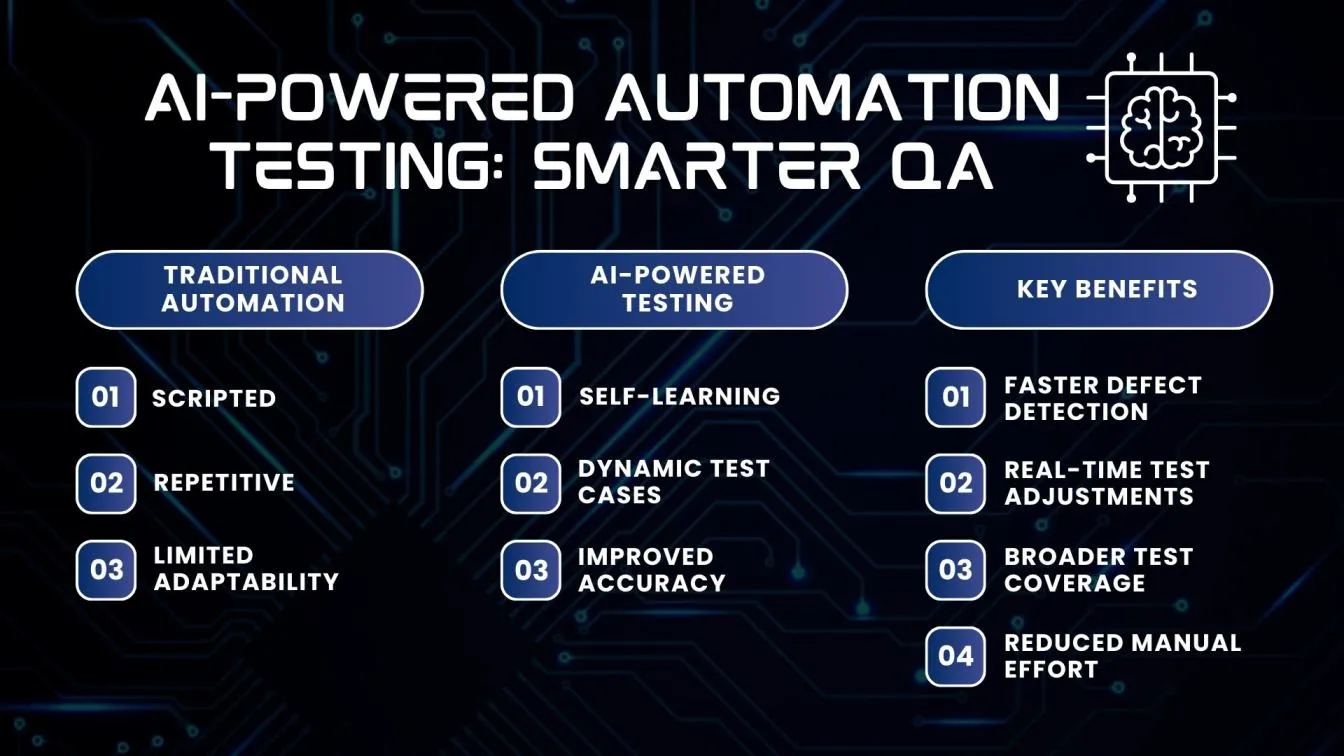
- Traditional Automation Testing:
- Features: Utilizes predefined scripts for repetitive tasks, offering basic automation capabilities.
- Benefits: Faster execution compared to manual testing, improved test consistency, and broader coverage.
- Constraints: High initial setup costs, ongoing maintenance needs, and lack of adaptability to dynamic changes.
- AI-Driven Automation Testing:
- Features: Uses AI and machine learning programs from human language for dynamic test case generation and anomaly detection.
- Benefits: Faster execution, better coverage, consistent results.
- Constraints: High setup costs, maintenance issues, limited adaptability.
Top AI Tools for Automation Testing
AI-powered testing tools ⚒️ require a strong understanding of various testing methods to maximize their potential in software testing. By leveraging AI, testers can automate complex scenarios, enhance coverage, and reduce manual effort.
Let's take a closer look at this one:
- Testim
- Focus: Enhances test automation with AI-driven capabilities for streamlined test creation and execution.
- Examples: Offers smart test creation using natural language, automated test maintenance, and insightful reporting.
- Use Case: Ideal for teams seeking to accelerate test development and improve test reliability through AI insights.
- Applitools
- Focus: Utilizes AI for visual testing and monitoring, ensuring UI quality across applications.
- Examples: Provides visual AI testing that automatically detects visual bugs, along with cross-browser testing and visual regression capabilities.
- Use Case: Best suited for teams focused on maintaining visual consistency across applications and quickly identifying UI issues.
- Mabl
- Focus: Uses AI to perform functional and regression testing.
- Examples: Automates test flows, intelligently detects visual changes, and offers API testing integrated with CI/CD pipelines.
- Use Case: Best for continuous integration environments needing smart test automation.
- Eggplant AI
- Focus: Leverages AI for intelligent test automation and performance optimization.
- Examples: Offers scriptless test creation, intelligent monitoring of application performance, and dynamic test adaptation based on user behavior.
- Use Case: Suitable for organizations aiming to improve the quality and speed of testing while reducing maintenance overhead through AI-driven insights.

The top AI tools for automated software testing include user-friendly platforms like Testim.io, utilizing machine learning in automation testing. Dynamic features like continuous learning and adaptive testing enable these tools to adapt to changing user behavior and environments. Common AI tools used in automated testing include OpenCV, TensorFlow, and PyTorch. These tools power backend systems and enable extensive management and access management of test data and workflows. By leveraging these AI tools, developers can streamline their testing processes.
How AI Detects Flaws in Test Coverage and Execution
AI-powered testing is revolutionizing the way we ensure software quality by leveraging advanced algorithms to identify gaps and predict potential issues 🕰️. With AI, testers can:
- Anomaly Detection: Identifies unexpected behavior or discrepancies in test results, highlighting potential issues that require immediate attention 🚨.
- Coverage Analysis: Assesses which parts of the application are tested and identify untested areas, improving overall test coverage and ensuring that all critical areas are thoroughly evaluated 📊.
- Predictive Insights: Uses historical data to predict areas of potential failure, allowing for preemptive adjustments to mitigate risks and improve the overall customer experience 💡.
- Real-Time Adjustments: Dynamically adjusts test cases and strategies based on ongoing test results and system changes, ensuring that the testing process remains efficient and effective ⏱️.
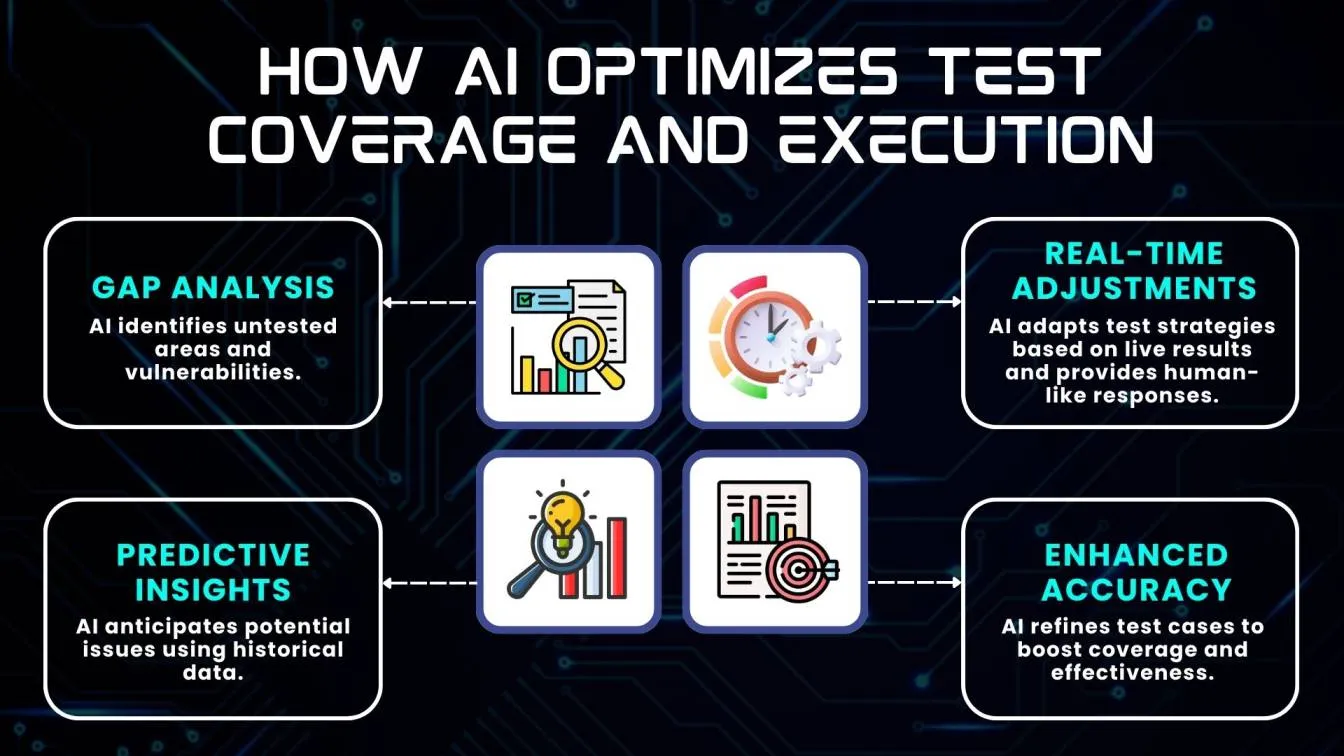
By leveraging AI-driven testing, organizations can:
- Improve Customer Experience: Deliver high-quality software products that meet customer expectations by identifying and addressing issues early on 👍
- Enhance User Experience: Provide users with a seamless and intuitive experience by testing applications across a wide range of devices, browsers, and scenarios 📱.
- Address Wide-Ranging User Input: Test software applications for diverse user input, including various languages, cultures, and accessibility requirements 🌎.
Top Signs Your Product Needs AI for Automation Testing
AI can revolutionize your testing processes, leveraging Machine Learning and Deep Learning techniques. 🚀 AI-driven key features or advanced features like Predictive Testing and Intelligent Test Scripting integrate with backend systems for efficient testing. The integration of AI with real-time development and continuous deployment models can make testing a challenging task, but also a powerful tool to ensure downstream tasks are executed efficiently.
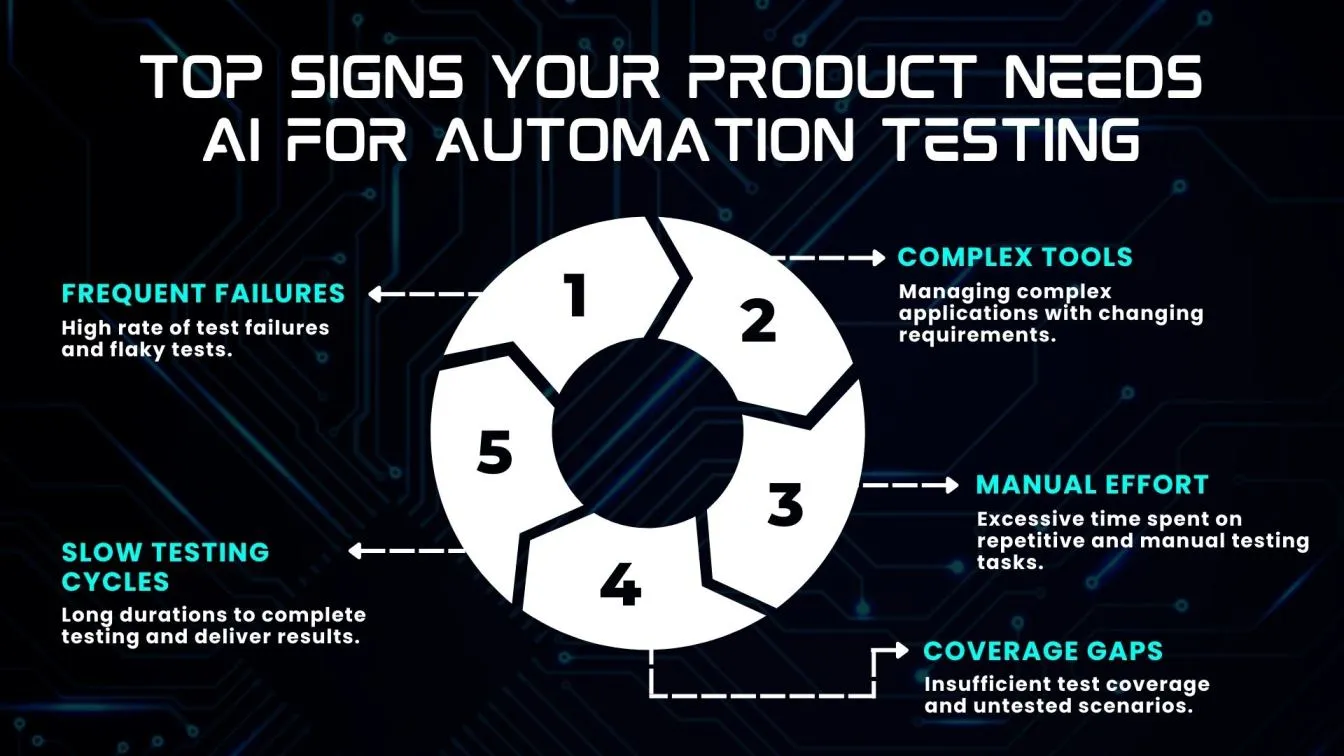
Signs You Need AI for Automation Testing
- High Failure Rate: Persistent test failures indicate that automation alone may not be sufficient, and AI could help improve reliability.
- Extended Testing Time: Long testing cycles suggest a need for AI to speed up processes and enhance efficiency.
- Incomplete Coverage: Gaps in test coverage signal the need for AI to ensure comprehensive testing across all scenarios.
How Can AI Help Enhance Your Product’s Quality Assurance?
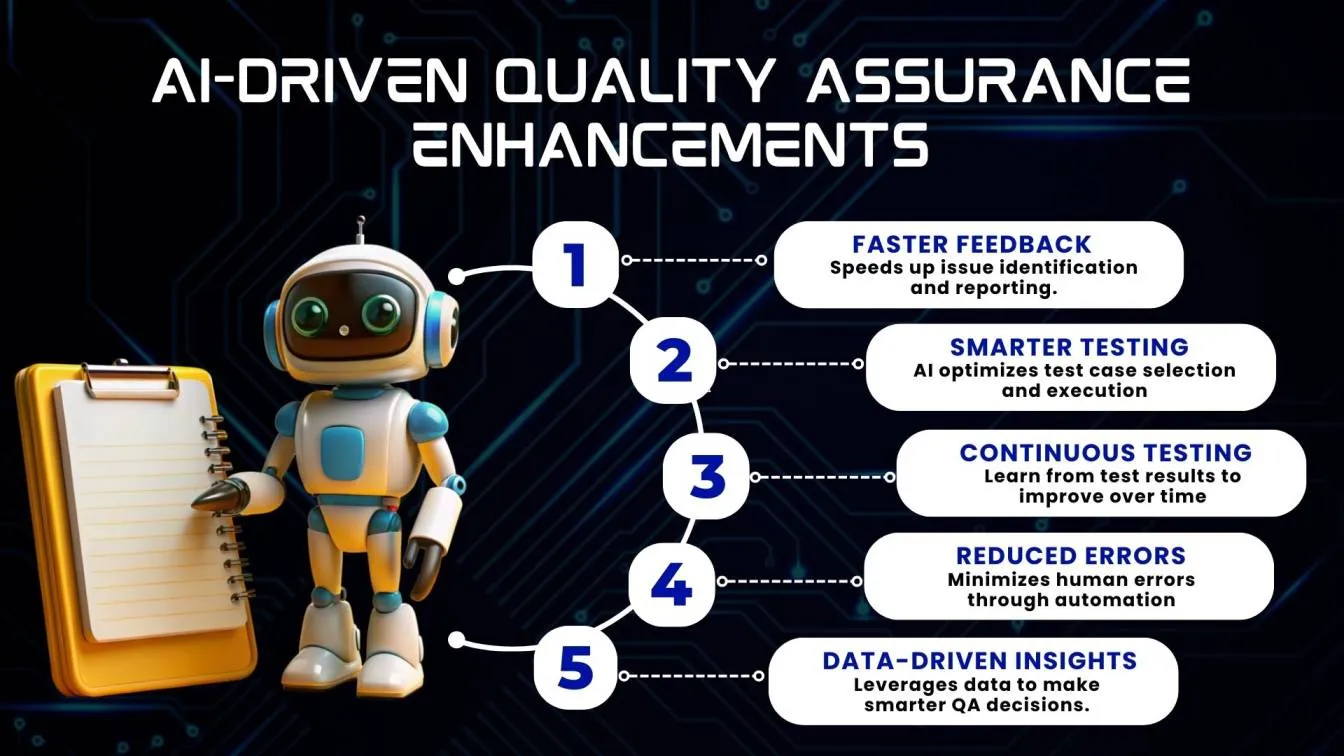
AI enhances quality assurance by automating repetitive tasks and analyzing large datasets for insights. It helps identify defects early, improve test accuracy, and adapt to evolving product requirements, ensuring higher quality and faster releases.
- Automated Testing: AI speeds up test creation and execution, reducing manual effort and increasing efficiency.
- Preprocessing capabilities: AI analyzes test results to identify defects more accurately and consistently.
- Predictive Analytics: AI predicts potential issues based on historical data, helping to prevent problems before they arise.
- Real-Time Adjustments: AI dynamically updates test cases and strategies in response to real-time changes and new data.
- Broader Coverage: AI ensures comprehensive test coverage by exploring more scenarios and edge cases than traditional methods.
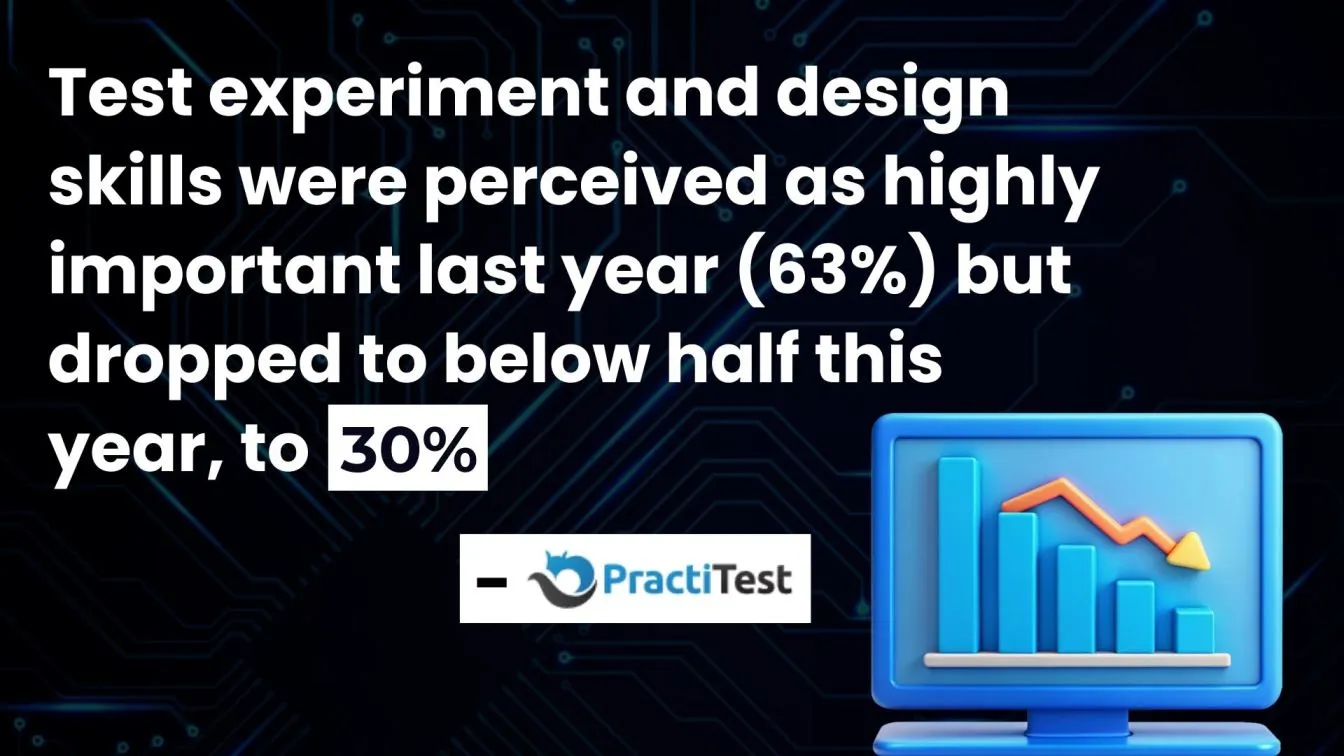
Reducing Testing Costs Through Automated Test Execution
Automated test execution can significantly cut down on testing costs by minimizing manual effort and increasing testing efficiency. 🚀It speeds up time-to-market, lowers errors, and streamlines procedures.
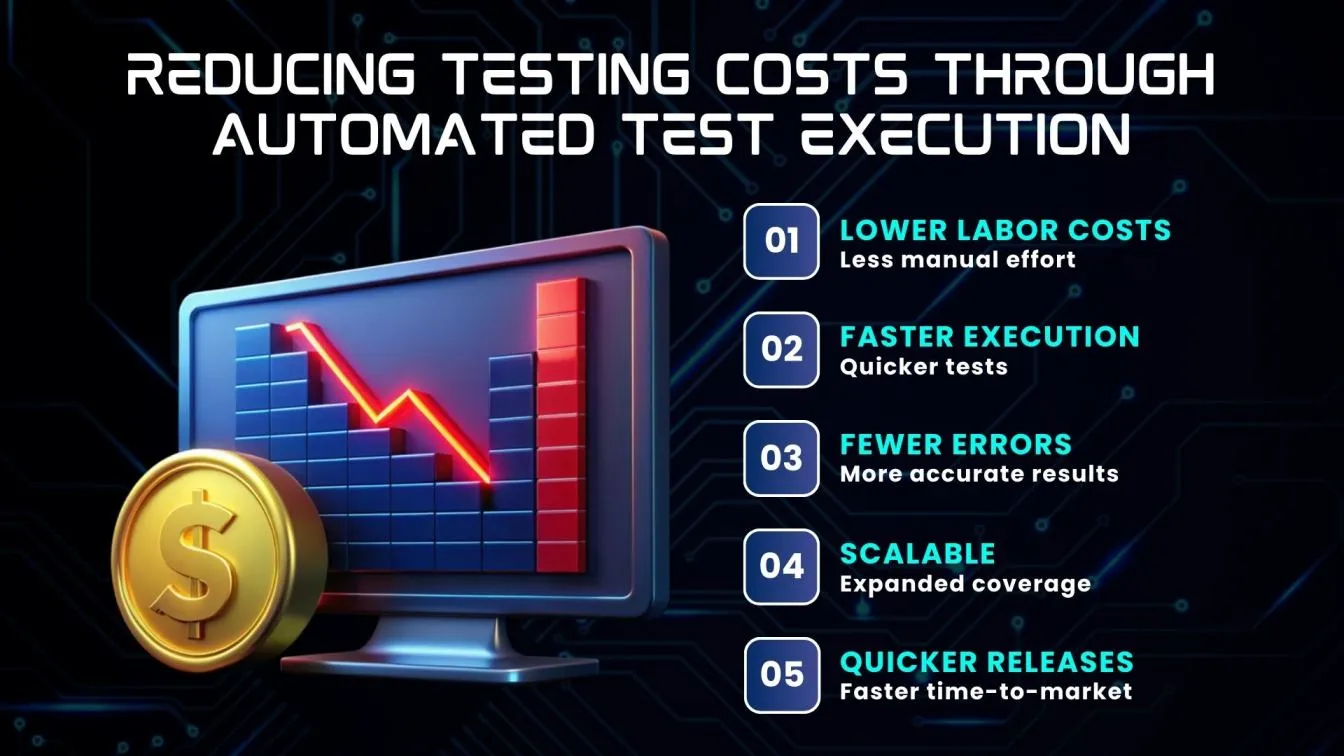
- Reduced Labor Costs: Automation lowers labor costs by eliminating the need for labor-intensive manual testing. 💸
- Enhanced Efficiency: The testing activities is expedited overall because automated tests execute more quickly than manual tests.
- Decreased Error Rates: Automation reduces the possibility of human error, producing outcomes that are more accurate. 🎯
- Scalability: Scalability that manual testing cannot provide, automated testing can handle higher test volumes without requiring proportionate increases in time or resources. 📈
- Optimization of Resources: Repetitive processes can be automated to maximize efficiency by reallocating personnel to more strategic testing initiatives. 🔄
- Regular Testing: Automated test execution guarantees consistency and dependability in testing results by executing the same test cases in the same manner each and every time. 📋
Understanding AI’s Role in Modern Automation Testing and QA
AI transforms automation testing solutions and QA by enhancing efficiency, accuracy, and adaptability.🤖 It leverages machine learning program from human language to improve test coverage and streamline testing processes, making it essential for modern software development.
- Smarter Test Creation: AI generates and updates test cases based on application changes. 📋
- Enhanced Accuracy: Reduces human errors and ensures precise testing results. 🎯
- Dynamic Adaptability: Adjusts test strategies in real-time to address evolving requirements. 🔄
- Predictive Analytics: Uses historical data to forecast potential issues before they occur. 📈
What Makes AI Crucial for Automation Testing?
AI is a game-changer in automation testing, offering unique advantages that elevate testing processes by enhancing precision, speed, and flexibility. 🤖🚀
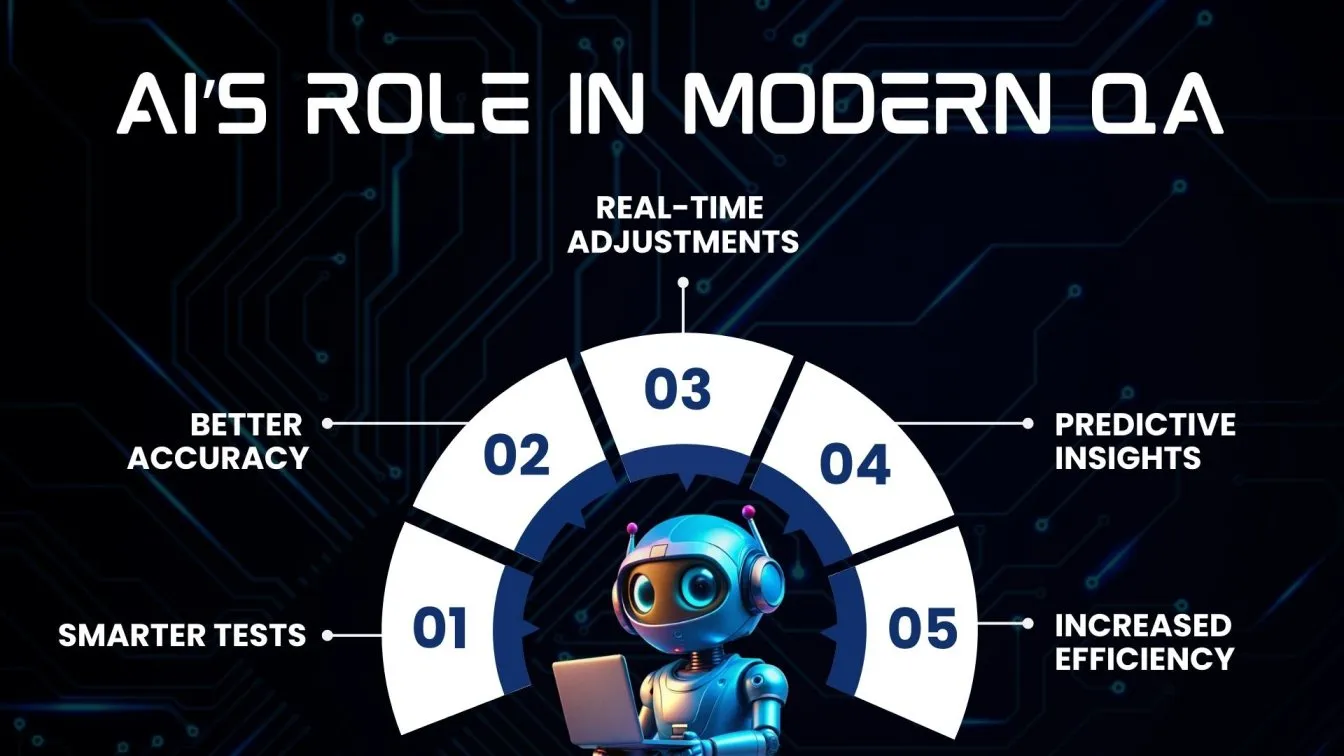
- Improved Accuracy: AI minimizes human errors by automating complex and repetitive tasks. 🎯
- Smarter Test Case Generation: AI generates and prioritizes test cases based on data, reducing redundancy. 📊
- Real-Time Adaptation: AI adapts to changes in code and requirements quickly, ensuring tests remain relevant. 🔄
- Enhanced Test Coverage: AI improves overall test coverage by identifying crucial areas through massive dataset analysis. 🔍
- Cost and Time Efficiency: AI uses automation and wise resource allocation to cut down on testing time and operating expenses. 💰
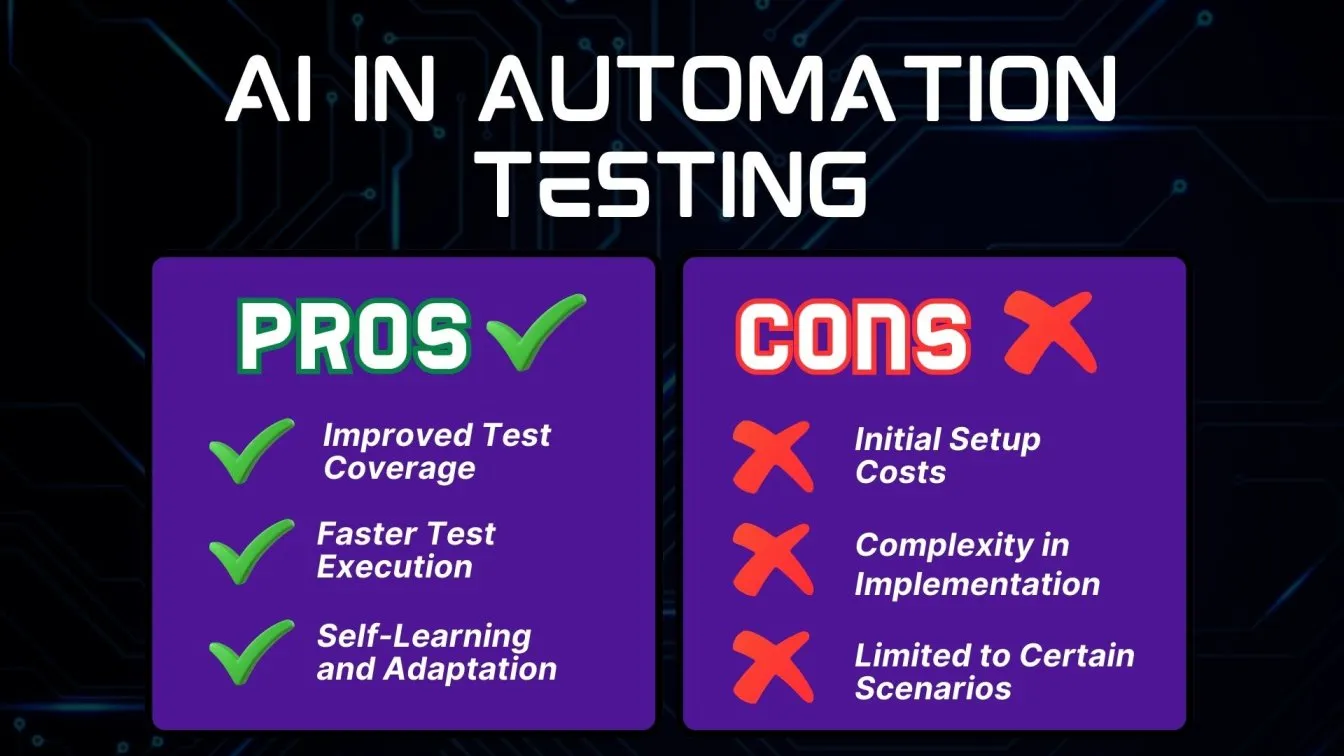
AI-powered chatbots simulate real-world user interactions, leveraging NLP and ML to understand customer queries. Conversational AI enables NLP chatbots to adapt to changing user intent and respond accordingly. By incorporating chatbots into automation testing, developers can ensure thorough testing for real-world scenarios, improving user experiences and customer satisfaction.
The Challenges and Limitations of AI in Testing and QA
AI improves QA automation testing, but it also has drawbacks. These include problems with the quality of the data, the difficulty of execution, and sustaining efficacy over time. 🤏🤔
- Data Quality: Large, high-quality datasets are essential for AI, as inadequate data might produce unreliable findings. 📉
- Difficulty in integration: It can be difficult and resource-intensive to integrate AI into current systems. 🛠️
- Ongoing Maintenance: AI models need to be updated frequently in order to stay functional. 🔄
- Context Limitations: AI might have trouble understanding complex situations that call for human judgment.

Practical Applications of AI in Automation Testing
AI is transforming the automation testing process by providing practical solutions that enhance efficiency, effectiveness, user stories and customer satisfaction. From intelligent test generation to anomaly detection, AI helps streamline the testing process and ensure robust software quality. 📈
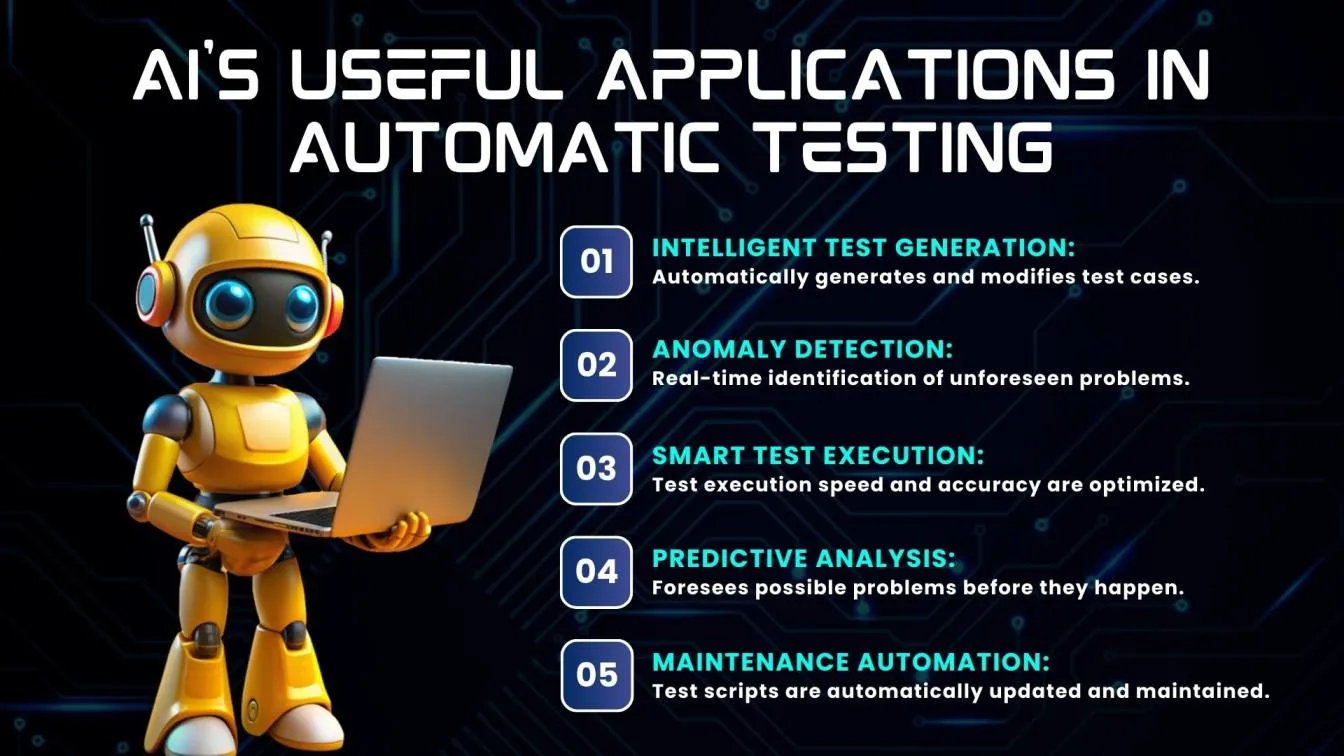
● Smart Test Creation: AI generates and updates test cases automatically, saving time and resources 💡.
● Anomaly Detection: AI identifies real-time issues during test execution, enhancing test accuracy 🔍.
● Optimized Test Execution: AI executes tests more efficiently and excellence in software testing processes⏱️.
● Predictive Insights: AI anticipates potential issues using data analysis, potential risks 📈.
● Automated Maintenance: AI updates and maintains test scripts dynamically🔄.
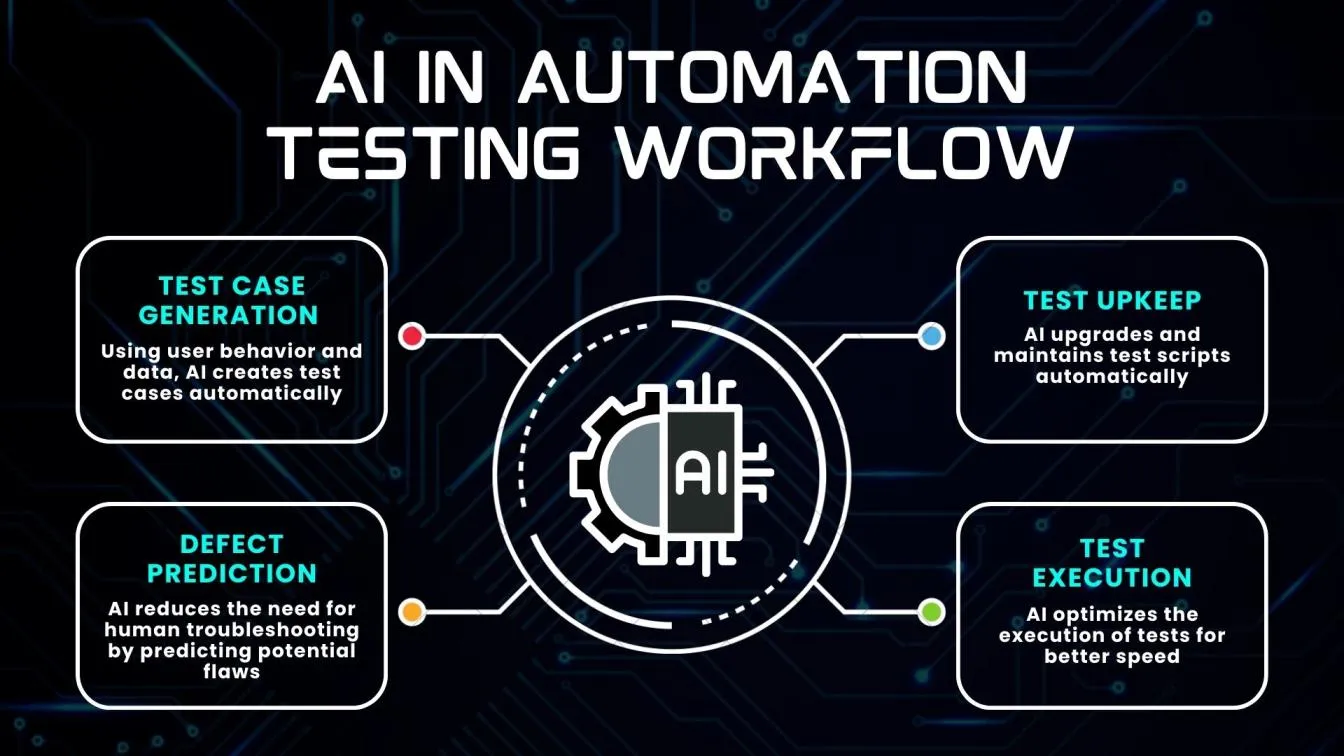
The Benefits of AI in Automation Testing
● Accurate Responses: AI-driven testing tools ensure accurate responses to customer queries, improving customer satisfaction 👍.
● Enhanced Customer Engagement: AI-powered reporting real-time issue detection and resolution, enhancing customer engagement 💬.
● Speech Recognition: AI-powered speech recognition technology enables accurate voice command recognition and automates testing processes 🗣️.
● Language Models: AI-powered language models analyze user flows and generate test cases that simulate real-time insights 📊.
● Human Speech and Conversation: AI-driven approaches simulates human speech and human conversation patterns, ensuring that software applications are tested for real-world scenarios 💬.
The Advantages of AI Over Traditional Automation Testing Methods
AI has significantly enhanced automation testing approach by addressing the limitations of traditional methods. With AI, testing becomes more dynamic, predictive, and capable of handling complex scenarios that traditional methods struggle with. 💡
- Enhanced Accuracy: AI reduces human error and increases the precision of test results. 🎯
- Dynamic Adaptability: AI adjusts quickly to changes, unlike traditional methods that are more static. 🔄
- Predictive Capabilities: AI anticipates potential issues before they occur, offering proactive approaches. 📈
- Efficient Scaling: AI can manage extensive test environments more effectively than manual testing methods. 📊
- Real-Time Updates: AI systems continuously update test cases and scripts, unlike manual methods that require periodic updates. ⏱️

- Real-World Applications
- AI-powered automation testing tools are used in industries such as finance, healthcare, and e-commerce to ensure the quality and reliability of software applications.
- AI-driven testing is used in robotics and IoT to simulate complex scenarios and ensure that devices are tested for real-world applications.
- API Integration
- AI-powered automation testing integrates with APIs to simulate real-world scenarios and automate code review.
- APIs enable seamless integration with automation testing frameworks, allowing for real-time data exchange.
- Human Language and Relevant Responses
- Natural Language Processing (NLP): AI-powered NLP enables you to analyze language identifiers like speech tagging, contextual understanding of user feedback and sentiment analysis, providing insights into user behavior ,user friendly and consistent user experiences.
- Automatic Testing: AI-driven automation testing automates repetitive tasks, reducing testing time and response time.
Enhancing QA Accuracy with AI-Driven Insights
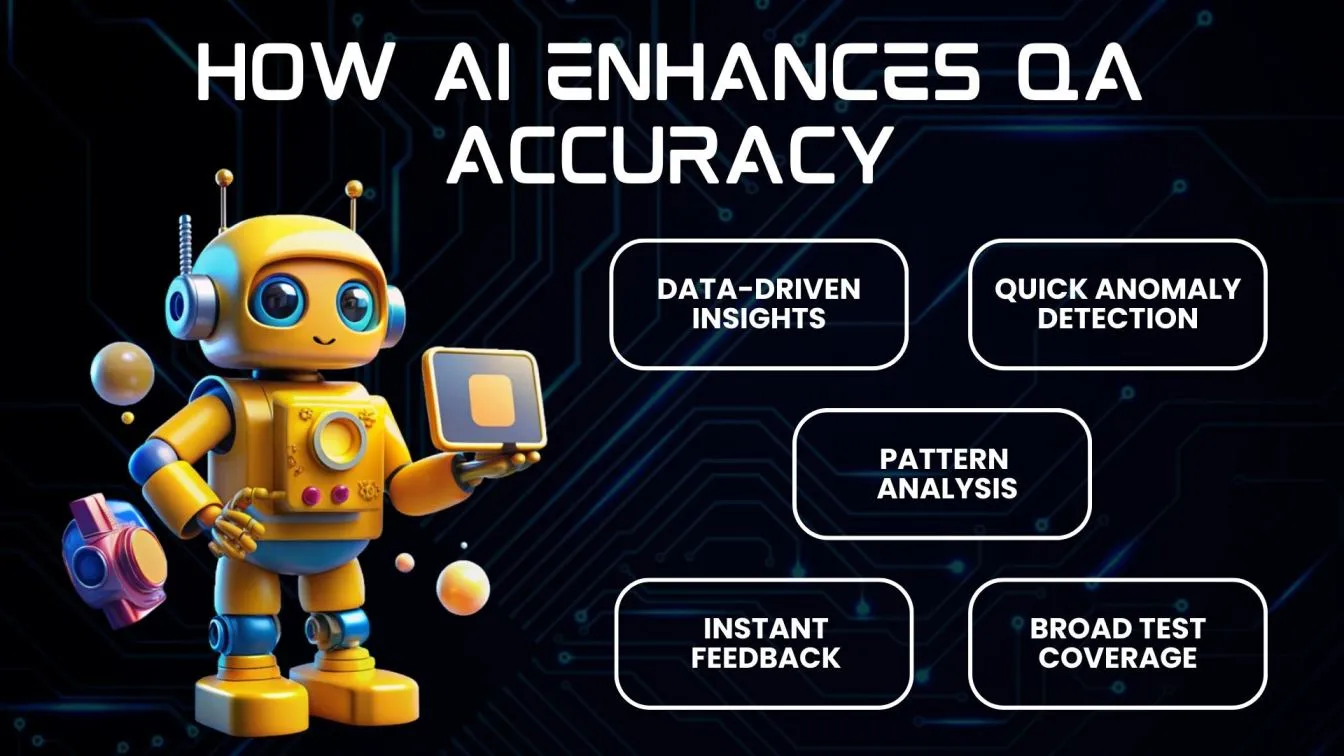
Quality Assurance (QA) tools are being revolutionized by AI-driven insights that offer faster algorithms and precise evaluations of test findings. AI improves key aspects as prioritization in testing like accuracy of QA procedures by utilizing intelligent algorithms and machine learning, which enables teams to recognize and resolve problems more successfully. 🤖🔍 This method guarantees a greater quality of software delivery.
- Data-Driven Accuracy: AI is driven by data to provide accurate insights by analyzing large datasets. 📊
- Anomaly Detection: Reduces false positives by promptly identifying potential risks. ⚠️
- Pattern Recognition: Detects recurring problems and trends in testing services. 📈
- Real-Time Feedback: identifies trends and recurring issues ⏱️
- Improved Coverage: Ensures comprehensive testing across all scenarios. 🌐
Key Benefits of AI-Driven Insights in QA Accuracy
● Improved Precision: AI identifies defects more accurately, leading to higher quality software
● Optimized Batch Testing: AI refines test cases based on data analysis, ensuring critical areas receive focus. 🎯
● Reduced Manual Effort: AI automates repetitive testing tasks, freeing teams to focus on complex issues. 🤖
● Continuous Testing: AI continuously learns from data, improving testing accuracy and efficiency. 🔄
Conclusion
AI is revolutionizing automated testing and QA by boosting accuracy, efficiency, and adaptability. Tools like Testim, Mabl, Applitools, Eggplant AI help uncover hidden flaws 🔍 while cutting down manual effort and providing actionable insights 💡 to speed up decision-making, ensuring faster and more reliable testing cycles.
Conversational AI, like smart chatbots powered by pre-trained models and knowledge bases, can automate parts of testing by simulating human interactions, quickly identifying defects, and ensuring smoother, more efficient testing processes.
AI-driven tools are transforming software testing by analyzing large datasets, predicting failure points, and optimizing test cases, making the process more efficient. While human expertise is essential for complex decision-making, AI automates repetitive tasks, reduces errors, and accelerates development cycles 🚀. AI also improves user interfaces by detecting usability issues early, ensuring a seamless product for end-users
People also asked
👉 What are the main benefits of using AI in a process for quality control?
Businesses can automate testing procedures with less human agent intervention and more complex testing scenarios by utilizing AI in quality assurance. AI-driven solutions increase testing operations' productivity by providing better scalability and precision.
👉 Is AI able to completely replace human testers?
Artificial intelligence (AI) cannot completely replace human testers, particularly in complicated scenarios requiring creativity and sophisticated problem-solving. Specialized knowledge of humans is still necessary to handle complex and unusual testing problems.
👉 What skills are required to manage AI-based automation testing?
Skills needed include knowledge of AI/ML algorithms, proficiency in complex tools, programming, and a deep understanding of QA methodologies.
👉 How can AI improve test coverage in automation testing?
AI intelligently selects and prioritizes test cases, expanding coverage by focusing on critical areas and uncovering hidden defects.
👉 What Are the Main Goals of AI-Powered Automation in QA?
The primary goals are to enhance efficiency, increase accuracy, reduce costs, and ensure comprehensive, adaptive testing.
👉 The Impact of AI on Job Roles in Testing
AI shifts testers' roles toward strategic tasks, focusing on test design, analysis, and oversight, while automating repetitive tasks.





%201.webp)

